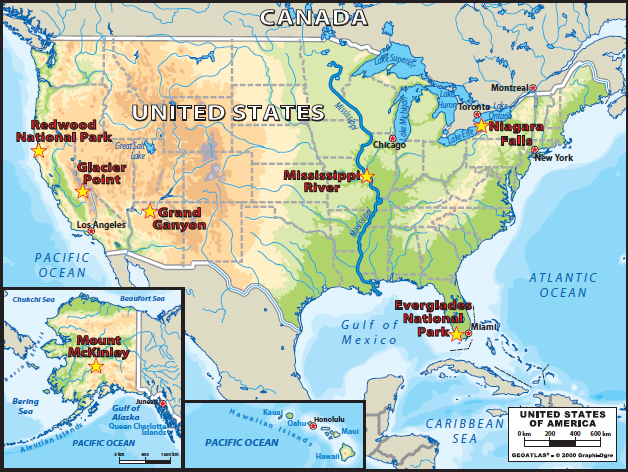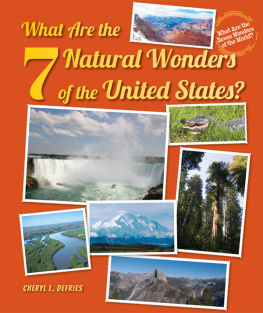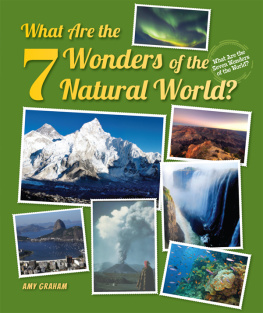Natural Wonders of the United States
Seven spectacular natural wonders can be enjoyed from coast to coast within the United States. These include: the Everglades, Glacier Point in Yosemite National Park, the Grand Canyon, the Mississippi River, Mount McKinley in Denali National Park, Niagara Falls, and the Redwood Forest. Discover these majestic works of art, shaped by natural forces, seen and unseen by humans.
ABOUT THE AUTHOR
Cheryl L. DeFries wrote three screenplays before discovering another lovewriting books for young people. In addition to writing, she enjoys entertaining, cooking, decorating, and travel.


Image Credit: Jill Lang/ 2011 Photos.com, a division of Getty Images. All rights reserved.
Water cascades down American Falls. These are located on the New York Side of the falls.
The Everglades
- Covers 1,296,500 acres (524,686 hectares)
- Everglades National Park in Florida is the largest designated wilderness area east of the Rocky Mountains
- Most significant breeding ground for tropical wading birds in North America
Glacier Point: Yosemite National Park
- Located in the California Sierra Nevada Mountains, 150 miles (241.4 kilometers) east of San Francisco
- Glacier Point is a 3,200-foot (975.4-meter) high granite cliff
- Yosemite Falls, which begins at Glacier Point, is the tallest waterfall in North America
Grand Canyon
- The Grand Canyon is about a mile (1.6 kilometers) deep from the top to its floor
- The Grand Canyon covers 1,217,403 acres (493,048 hectares)
- The black-bellied, white-tailed Kaibab squirrel lives on the North Rim of the Grand Canyon and its habitat has been named a National Natural Landmark
Mississippi River
- The Mississippi River is one of the worlds busiest rivers
- At 2,350 miles (3,781 kilometers) long, it is the second longest river in North America
- Nearly a half million pounds (227,000 kilograms) of sediment are moved by the Mississippi River each day
Mount McKinley: Denali National Park
- At 20,320 feet (6,197.5 meters) high, Mount McKinley is the tallest mountain and highest point in North America
- Mount McKinley is part of the 600-mile (965.6 kilometer) long Alaska Mountain range
- The North Peak of Mount McKinley was first climbed by Peter Anderson and Bill Taylor on April 3, 1910
Niagara Falls
- Niagara Falls is located on the border of the United States and Canada
- Niagara Falls is the largest waterfall in North America and the second largest waterfall in the world
- The Niagara Rivers normal water flow is 212,000 cubic feet (6,003,170 liters) per second
Redwood Forest
- There are three types of redwood trees left in the world
- Giant sequoias can grow nearly 275 feet (83.8 meters) tall
- Coast redwoods average 350 feet (106.7 meters) in height and 18 feet (5.5 meters) in width
Seven spectacular natural wonders can be enjoyed from coast to coast and border to border in the United States and Canada. Many of these marvels have been created over millions of years. Glaciers, water, ice, wind, erosion, and the movement of the earths plates have produced them.
The location of these wonders varies quite a bit. On the East Coast is the Florida Everglades, a subtropical wetland. The subtropics are areas that border the tropical regions, and the Everglades is the largest subtropical wilderness in the United States. On the West Coast, California has two natural wonders. Glacier Point, in Yosemite National Park, is made of solid granite, and the tallest living trees in the world are found in the Redwood Forest. Alaska is home to Mount McKinley, the tallest mountain in North America. The Grand Canyon is in Arizona. The Canadian province of Ontario and the state of New York share the Niagara Falls, and the Mississippi River passes through ten states.
These seven natural wonders are all different, but they share something in common. They are majestic works of art, shaped by natural forces, seen and unseen by humans.
The United States and Canada are filled with natural wonders. We chose the seven that seemed to be the most famous and most studied. However, there are many more. For example, two natural wonders can be found in Utah. The Rainbow Bridge is the worlds largest natural bridge. Arches National Park has over one hundred natural sandstone arches.

Image Credit: Enslow Publishers, Inc.
This map of the United States and part of Canada shows the location of each of the wonders profiled in this book.
Crater Lake, in southwest Oregon, is a blue lake in a volcanic crater. Death Valley in southwest Nevada and southeast California is a desert and the lowest point in the Western Hemisphere. Central Kentuckys Mammoth Cave is the longest cave system in the world.

Image Credit: rabbit75_ist/ 2011 Photos.com, a division of Getty Images. All rights reserved.
A view of the Grand Canyon in the winter from the South Rim.
The Petrified Forest and part of the Painted Desert containing petrified trees and logs are in eastern Arizona. Yellowstone National Park is located in three states: Wyoming, Idaho, and Montana. Yellowstone is the home of hot springs, waterfalls, and a geyser called Old Faithful.
The four largest volcanoes on earth are located on the big island of Hawaii. They are Mauna Kea, Mauna Loa, Hualalai, and Kohala. Mauna Loa, in fact, is the largest active volcano in the world. California has the La Brea and McKittrick tar pits, which contain numerous preserved fossils.
Canada is home to the Bay of Fundy. This is the place that has the largest tides in the Atlantic Ocean.
As you can see, splendid natural wonders can be found throughout the United States and Canada. Nature has entrusted her treasures to the human race. It is our responsibility to protect and preserve these amazing creations for our generation and future generations.
The eastern sky glowed a fiery orange as the sun rose and cast a warm glow on the bleached branches of a mangrove tree. A thin haze drifted close to the water, cloaking it in a veil of mystery. It was summertime in the Everglades, and the heat and humidity of midday had not yet moved the areas inhabitants into their usual drowsy but watchful state.
A young frog watched a droning dragonfly. It hopped from a lily pad onto the shore and watched the insect dart in and out among the reeds. The dragonfly skimmed the water and came to rest on the root of a cypress tree. The frog saw its chance for an early morning meal and sprang to life. It landed near a mud-covered, half-submerged log.
In a blink of an eye, the frog disappeared as the logs murderous jaws opened and shut.
As the mud settled back around the alligator, the air was filled with a machine-gun-like chatter. A dark form flew over the water. It was still dark enough that the bird was hidden from view; only the sound of its wings gave away its position. It braced its wings against the cool morning breeze and glided toward a sandbar. With a few sweeps of its large wings, it settled down, inches from its prey.












